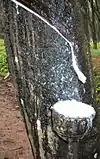Crepe rubber
Crepe rubber is coagulated latex that is rolled out in crinkled sheets and commonly used to make soles for shoes and boots but also a raw material for further processed rubber products.

Latex collection from a rubber tree
Processing
Colloidal latex is first mixed with formic acid to cause it to coagulate. The coagulum is processed in a "creping battery", a series of machines that crush, press and roll the coagula. The sheets are hung in a heated drying shed and then sorted by grade and packed for shipping.
Types
There are several types and grades of rubber crepe, mainly distinguished by the grade and pre-processing of the latex used in their manufacture.[1]
- Pale latex crepe (PLC) is a premium grade, made from raw field latex.
- Estate brown crepe (EBC) is made from "cup lump" (raw, naturally coagulated rubber from the collection cup) and other coagula.
- Re-milled crepe is made from "wet slab coagulum" (cured latex, still wet from the coagulation tanks), latex sheets (unsmoked) and cup lump.
- Smoked blanket crepe is made from thick sheets of latex that have been processed in a smoker.
- Flat bark crepe is made from scraps and other poor quality raw product.
Gallery
 Hand-powered latex creping machines
Hand-powered latex creping machines Removing coagulum from coagulating troughs
Removing coagulum from coagulating troughs Creping battery
Creping battery Milling honey-colored crepe
Milling honey-colored crepe Milling white crepe
Milling white crepe Spooling crepe from last finishing mill
Spooling crepe from last finishing mill Smooth crepe spooled for transfer to the drying shed
Smooth crepe spooled for transfer to the drying shed Wet coagulum crepe blanket
Wet coagulum crepe blanket Smallholder's sheet in a drying shed
Smallholder's sheet in a drying shed White crepe hanging in a drying shed
White crepe hanging in a drying shed Laminating white crepe for sole crepe
Laminating white crepe for sole crepe Laminating honey-coloured crepe for sole crepe
Laminating honey-coloured crepe for sole crepe Sole crepe inspection and packing
Sole crepe inspection and packing
References
- Cecil, John; Mitchell, Peter; Diemer, Per; Griffee, Peter (2013). "Processing of Natural Rubber, Manufacture of Latex-Grade Crepe Rubber". ecoport.org. FAO, Agricultural and Food Engineering Technologies Service. Retrieved March 19, 2013.
This article is issued from Wikipedia. The text is licensed under Creative Commons - Attribution - Sharealike. Additional terms may apply for the media files.